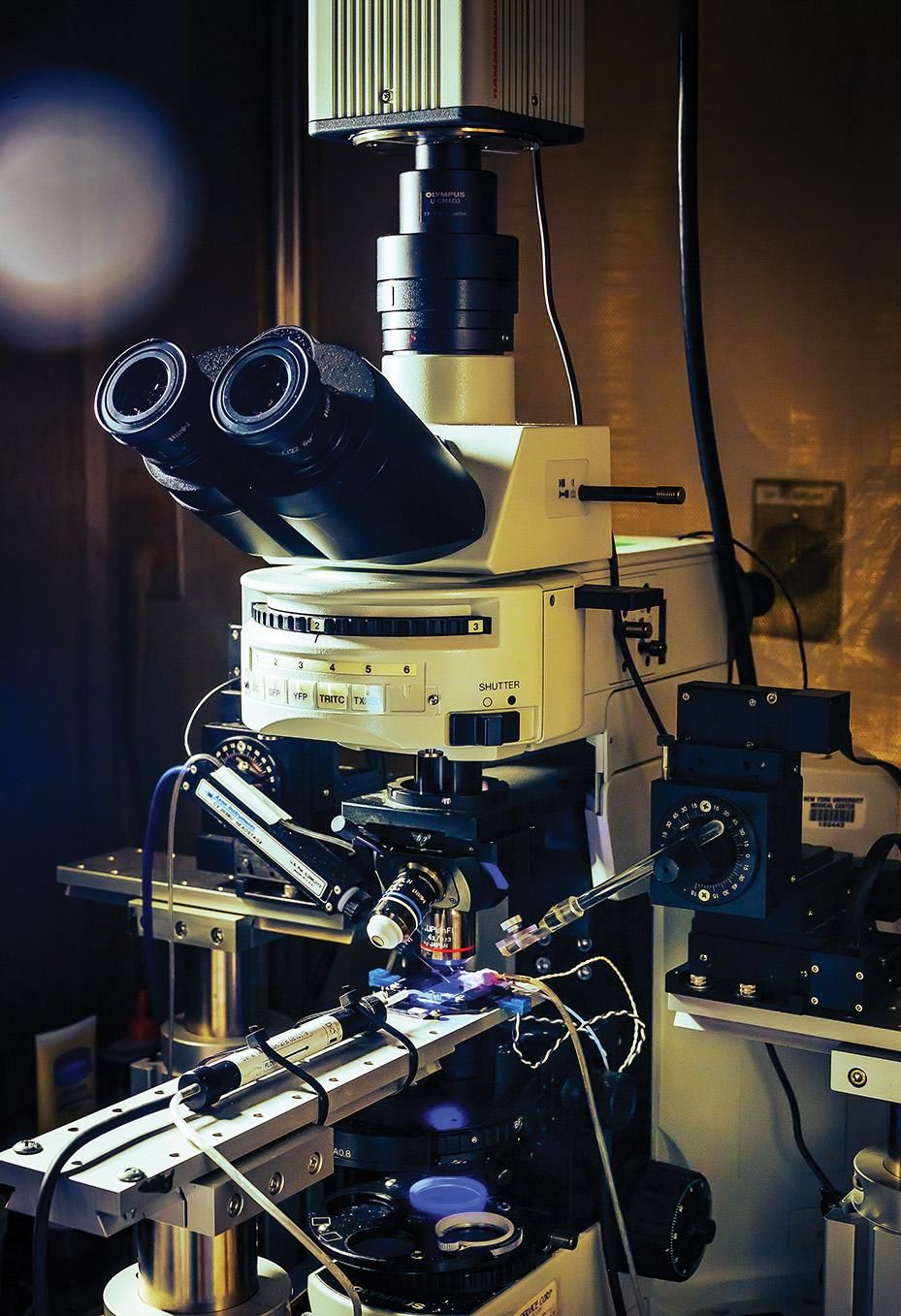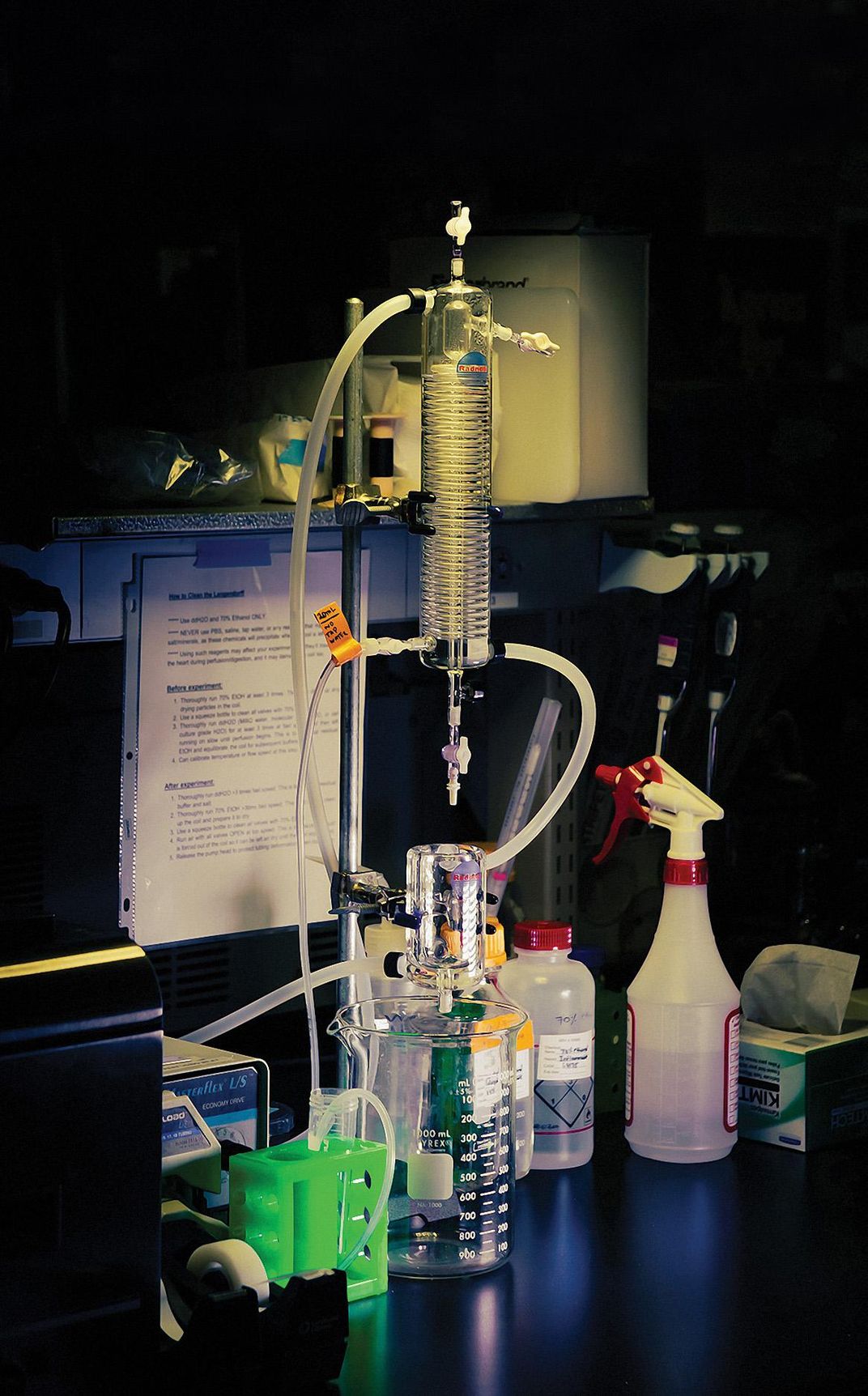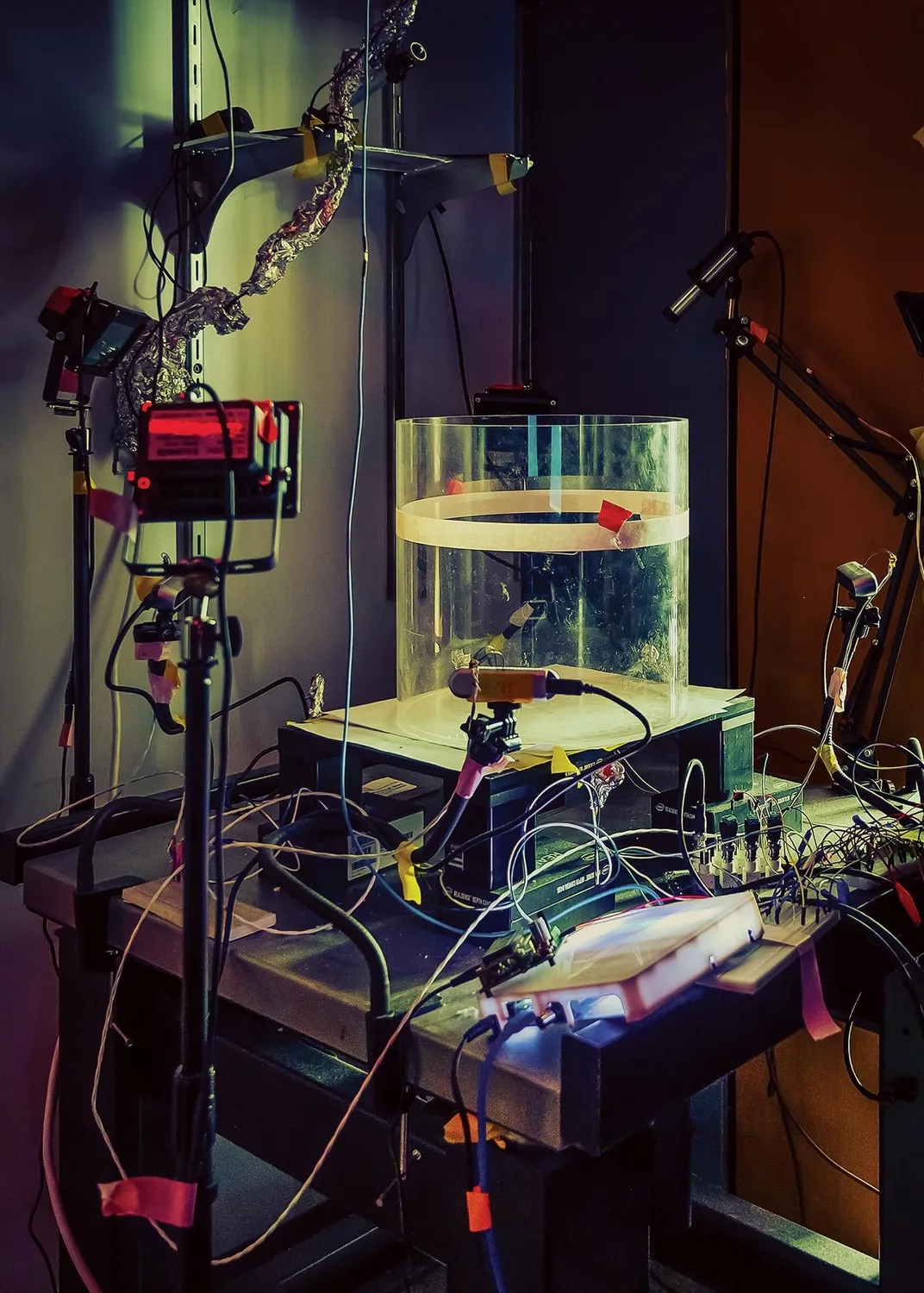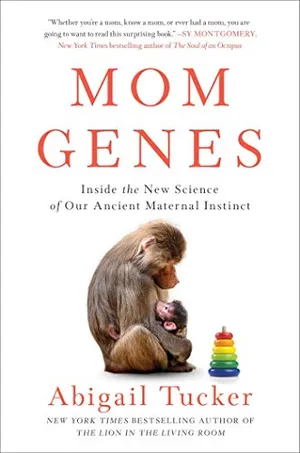"It feels like I grew a new heart." That’s what my best friend told me the day her daughter was born. Back then, I rolled my eyes at her new-mom corniness. But ten years and three kids of my own later, Emily’s words drift back to me as I ride a crammed elevator up to a laboratory in New York City’s Mount Sinai Hospital, where cardiologists are probing the secrets of maternal hearts.
Every year, thousands of pregnant women and just-delivered mothers land in emergency rooms with a life-threatening type of heart failure. Symptoms include swollen neck veins and shortness of breath. Their hearts have a harder time pumping. The underlying cause of this “peripartum cardiomyopathy” is unclear, but it’s the kind of health disaster that, for other people, can end in a heart transplant, or oblivion.
Yet fate has a different design for fledgling mothers. About 50 percent spontaneously get better, the highest rate of recovery from heart failure for any group. Some maternal hearts are practically as good as new in as little as two weeks. Adult heart tissue doesn’t rally easily, but new mothers may somehow be able to regrow heart cells the way salamanders sprout new tails.
At this Mount Sinai Hospital lab, a cardiologist named Hina Chaudhry thinks she has figured out why. In tests involving lab mice, which were surgically operated on to simulate a heart attack, she and her research team discovered something astonishing: heart cells with DNA that doesn’t match the mother’s own.
The mystery cells belong to unborn mice. During pregnancy the fetal mouse cells cross the placenta into the mother’s body, joyriding through her blood vessels until cardiac damage happens, at which point they sense inflammation and make a beeline for her wounded heart. The lab has even found that these cells, harvested from mouse placentas, will travel to the damaged hearts of male mice after being artificially implanted in their tails.
“They just zoom in,” says Chaudhry. “These cells home to the heart like heat-seeking missiles.”
Multiplying in maternal chests, the fetal stem cells transform into blood vessel-like tubes and, more significant, cells that resemble full-fledged heart muscle cells, which cardiologists have struggled for decades to recreate in a lab. The mother’s crippled organ likely uses this fresh tissue to heal.
It feels like I grew a new heart.
On a nearby computer screen, Chaudhry pulls up highly magnified video footage of these fugitive fetal mouse cells in a petri dish. Tagged with a green fluorescent protein, they look like fresh peas in a dish of gray gravy.
She hits play, and the peas begin to pulse, to twitch. I squint. Why on earth, I ask, are the fetal cells bopping around like that?
Chaudhry grins. “They’re beating.”
It’s not just hearts. A mother’s body is like her living room, strewn with kid castoffs and debris. Scientists discover fetal cells in the darnedest places. Our children colonize our lungs, spleens, kidneys, thyroids, skin. Their cells embed in our bone marrow and breasts.
Often they stay forever. Scientists find rogue fetal cells while autopsying the cadavers of old women, whose babies are now middle-aged. Long after giving birth, the bodies of surrogate mothers are scattered with the genes of strangers’ progeny.
The phenomenon is called “fetal microchimerism”—“micro,” because these are typically teeny numbers of cells, only a handful per millimeter of blood in pregnant women, and fewer in moms later in life. A “chimera” is a type of awkward mythological Greek monster remixed from various familiar creatures.
On my computer screen I stare at statues of these ancient freaks cast in bronze: goat legs, lion heart, dragon wings and fire breath billowing out of one of three heads. That’s no monster, I think. That’s me most mornings. That’s a mom.
Until pretty recently, few scientists, especially in cutting-edge fields like neuroscience, were curious about the inner happenings of the two billion or so human moms patrolling the planet today. Blame the historically macho scientific establishment, if you must: Some thinkers trace this neglect all the way back to Charles Darwin, who lost his mother when he was 8 and maybe couldn’t bear to think about us too much, poor guy. It wasn’t until 2014 that the National Institutes of Health confessed its “over-reliance on male animals and cells” in research studies and mandated the inclusion of female animal models, mothers occasionally included.
But more scholars, many of them young women, are taking the time to actually investigate, and they’re discovering that mothers are not so ordinary. In fact, we may be more intriguing and complex than anybody imagined. And that’s what makes Chaudhry’s heart work so eye-catching. If you peer closely enough, mothers often look very different from the rest of humankind.
* * *
The first time I ever considered the hard science behind the tender maternal instinct was during a visit for this magazine to a famous vole laboratory at Atlanta’s Emory University. Larry Young, the lead researcher, told me how prairie voles’ unusual brain chemistry may enable them to form lifelong pair-bonds with their mates by recycling a much more basic and ancient mammalian system: the maternal circuitry that mobilizes when a female becomes a mother.
Though already expecting my second child at the time, I had always thought—or maybe willed myself to believe—that motherhood was an elective lifestyle rather than a biological predicament, one hat among many that I sometimes chose to wear, as opposed to my entire head and all its expensively educated contents. But Young was describing motherhood as an unseen and poorly understood cellular-level revolution that rebuilds the female brain.
In pregnancy, of course, our entire physical selves are in flux. Our moles may darken, our voices deepen (as Kristen Bell’s did while recording Frozen, requiring her to go back after pregnancy and rerecord parts of the soundtrack in her normal girlish tones). Our noses swell, our arches flatten, and our toenails fall off. Our hair can change color or gain curl. We may burp as if we’ve swallowed a bomb cyclone. The bile in our livers can stop flowing, causing us to itch like the dickens. And we become demonstrably more delicious to mosquitoes because of our increased body temperature and carbon dioxide output.

And yet all of this turmoil pales in comparison to what’s happening inside the maternal mind. Some of the changes might be good news: One recent study of more than 14,000 women suggested that women with three or more kids have a 12 percent lower risk of dementia. But many dangerous and opaque mental problems hound mothers, especially as they transition into the maternal mode. In the first month of motherhood a woman is 23 times more likely to have her first hospitalization for bipolar disorder than she is at any other time in her life.
These are all heavy hints that what’s transpiring within our brains is just as extreme as our external makeover. Over the course of a few short months, our brains are abruptly renovated, causing us to reinterpret familiar stimuli—a stranger’s face, or the color red, or the smell of a tiny T-shirt—in freaky new ways. Suddenly a child’s smile is our alpha and omega. Our old systems of desire have been rewired.
The most striking change in motherhood isn’t about how we look on the outside. It’s about how we see.
* * *
This became clear to me intuitively, as for many mothers, the instant I laid eyes on my first child, and found myself bowled over by perfection—her plentiful eyelashes, her barely there fingernails. But how can researchers recreate this primal epiphany in a laboratory?
Curiously, on the exalted subject of motherly love, studies of lowly lab rats often supply the best answers. Before having her first litter, a virginal rat doesn’t enjoy the presence of pesky rat babies in the slightest. Like my former self, a childless urbanite perhaps overly fond of a bottomless mimosa brunch, the pre-maternal rat will always choose eating snacks over hanging out with rat pups. And gluttonous rat maidens may happily nosh on the pups themselves.
This preference persists almost until the end of pregnancy. But as she gets ready to give birth, something momentous happens inside the rat mom-to-be. A rat mom will choose quality time with an infant over a straight-up hit of cocaine. She will brave an electric grid to reach pups, which a virgin rat wouldn’t risk even for the most lavish cornucopia. You can blind her, deafen her, muzzle her, disable her nose, even burn off certain bits of her brain—and scientists have done all of these things to rat moms. They don’t waver in their devotion.
Clearly we can’t study the habits of human moms by zapping them or ejecting babies from laboratory chutes, the way scientists have done with rodents. But there are other clever ways of testing just how powerfully babies trigger mothers.
For instance, they’ve figured out how to peek into our skulls to see what’s up when we inhale the fumes of our babies’ little heads. In a 2013 smell-based experiment, 30 women sniffed at a mystery item—a newborn’s cotton undershirt—as scientists watched their brains react via an fMRI scanner. The new mothers showed significantly greater activity in an area called the thalamus, which regulates consciousness, sleep and alertness.
Baby faces, too, are extra-stimulating to moms. One 2014 experiment, entitled “Here’s Looking at You, Kid,” pitted the attentional processing of 29 first-time moms against 37 non-mothers as they viewed pictures of disembodied heads of babies and adults floating against a black background. While both groups of women seemed to find the baby mug shots more engaging than the adults’ faces, the moms ogled the babies for measurably longer.
Perhaps most important, infant emotions move mothers profoundly. Our pupils dilate more when viewing distressed babies, and we are slower to look away. Our scalps register different electrical readings at the sound of baby screams.
Using a technique called near-infrared spectroscopy, Japanese scientists tracked how the oxygen levels of moms’ brains changed as they viewed emotional baby pictures—of happy babies, who had been playing with attractive toys, of enraged babies, from whom said toys were taken, and of fearful babies, who were being eyeballed by a strange male. The moms showed activation in an area on the right side of the prefrontal cortex while the women without children did not.
Mom Genes: Inside the New Science of Our Ancient Maternal Instinct
Mom Genes reveals the hard science behind our tenderest maternal impulses, tackling questions such as whether a new mom’s brain ever really bounces back, why mothers are destined to mimic their own moms (or not), and how maternal aggression makes females the world’s most formidable creatures.


All this suggests something already clear to veteran moms. Being a mom isn’t as simple as riding high on baby fumes and vibing off their button noses. As usual, pain accompanies pleasure.
“Sensitization” is science’s word for our experience. It’s almost as though our nerves extend out of our bodies. I think this is why mothers have a hard time watching movies or even TV commercials involving suffering children. We feel it too deeply.
It’s a little depressing to think of oneself as uniquely attuned to tears, but this perhaps explains why bawling babies on planes make me feel like I’m being boiled alive, a peeled tomato rolling across rough pavement. That’s maternal sensitivity for you.
* * *
Many scientists believe this sensitization involves oxytocin, a hormone made in the hypothalamus. “Oxytocin” means “swift birth” because it gushes into the bloodstream during labor and delivery and facilitates uterine contractions and milk letdown. Scientists have recently become captivated by its impact on the brain as well. Sometimes called the “love hormone” or the “trust hormone,” it is associated with social and romantic bonding.
Researchers like Robert Froemke at NYU Grossman School of Medicine suspect that oxytocin doesn’t just prepare women’s bodies for birth; doubling as a neurotransmitter, it also readies our brains for infant worship. Froemke’s lab members wanted to see if they could use oxytocin to watch a rodent brain transitioning to motherhood in real time. They set up a series of experiments, published in 2015 and now considered classics.
The lead researcher, Bianca Jones Marlin of Columbia University, picked female mouse virgins whose DNA had been manipulated to include extra code for brain cells that produce light-sensitive reactions. In this case, a blue light from a laser shining into the mouse’s skull would stimulate a natural oxytocin rush. Marlin whisked these genetically engineered mice off to the lab’s studio-grade sound booth and implanted brain probes to take readings from individual neurons. She broadcast pup distress calls, but the virgins remained unmoved. Their brains responded in a typically disinterested manner, with a jaded spike here or there.
Then she blasted the blue light.
Oxytocin flooded the auditory cortex, as it might in childbirth. Now when she played the pup distress calls, the virgin brains began to perk up, with more reactive spikes. Within three hours, the virgin readings matched those of the mothers. Exposure to oxytocin had somehow sensitized their neurons to the cries. “That was a pretty amazing thing to see over three hours,” says Marlin who, in the midst of her oxytocin studies, became a mother herself. “We replicated the birthing process in a single neuron.”
It seems female mice brains are built to sop up this oxytocin gush. Froemke’s researchers have detected a unique surge in the number of receptors in the auditory cortex of female mice that are ready for mating (that is, about 2 months old). While this lab group is focused on sound-related regions, the oxytocin receptor burst apparently occurs elsewhere, too, perhaps in areas related to other senses. It seems that some of the special neural equipment to handle the chemical rush of childbirth comes prefabricated.
Much less is known about the natural distribution of oxytocin receptors in human brains. But the data we have suggests that oxytocin also modulates human maternal behavior, whether we’re howling our way through labor and delivery—or getting paid to inhale the stuff in the lab. In several experiments, when women with no children snorted puffs of oxytocin, they, too, had enhanced responses to baby faces and infant cues such as crying and laughing, compared with women who’d only sniffed placebos.


But before anybody gets too excited about this smoking gun, this “mother molecule,” as one scientist described oxytocin to me—you should know that there is another well-regarded laboratory, also part of NYU, that studies the transformative maternal effects of an entirely different neurotransmitter: the pleasure chemical dopamine, which, like oxytocin, is produced by the mother’s own body. Still other labs remain keen on the lingering behavioral impact of progesterone, estrogen and other byproducts of the placenta, which seem to combine in precise ratios throughout pregnancy to prime the mother’s mind for the climactic hormonal tsunami of birth. And of course there’s prolactin, the breastfeeding hormone, and stress hormones to boot.
“No behavior is controlled by a single brain region,” warns Danielle Stolzenberg, a neuroscientist at the University of California, Davis. But to the extent that they’ve found a maternal locus of control, or a “central site” of mom behaviors, scientists often refer to a part of the hypothalamus, way down toward the brain’s core. The hypothalamus is “really important for the four F’s,” Stolzenberg says. “Feeding, fleeing, fighting, and . . . uh, mating.” And at the very front of the hypothalamus sits the “medial preoptic area,” or mPOA.
The mPOA can be stimulated to produce maternal behaviors. Surgically dismantling or anesthetizing it, on the other hand, makes maternal behaviors disappear in rats, to the extent that mothers no longer collect their screaming pups with their mouths. (The animals’ mouths still work fine in these experiments, since the moms remain proficient at gathering up Charleston Chew cubes and other treats. Babies simply no longer seem sweeter than candy to them.)
The mPOA tosses long nerve fibers, called axons, like lassos hither and yon to network with other important brain clumps. The most important axons tether it to a reward center related to motivation. In fact, together these two synced-up areas are sometimes called the “maternal circuit.” This packages baby cues together with reward.
But the whole maternal shebang ropes in many systems related to pleasure, stress, memory and practically everything else—and the more these connections fire up, the stronger they grow.
The jumble gets even more complicated when you make the jump from rodent brains to people brains, with our supersized cortexes that can override primitive impulses. What’s more, the mPOA is too small to see on MRIs, and way too deep down for EEGs to detect. We won’t be able to probe it in humans until our tools improve. At the moment, scientists have no way of determining the causes and effects of human maternal metamorphosis, even though they know where it transpires. They are adamant only that change occurs—that mothers are molten creatures.
* * *
But mothers can also be made without the chemically laced processes of pregnancy and birth: Just ask any adoptive parent. Under the right experimental circumstances, helpless newborns seem to be a stimulus powerful enough to create the maternal mindset without hormonal prompting. You simply stick a virgin mouse in a cage with a mother and her pups. During the first three to five days, nothing happens. You have to be very, very careful that the newcomer doesn’t eat anybody. But after about a week in close quarters with the babies, the deep-down systems start to awaken, and the former cannibal begins to act like a softy around the pups.
While I’m at Froemke’s lab, Naomi López Caraballo, another one of his graduate students, shows me a virgin mouse whose maternal instinct has been “unmasked” this way. With latex-gloved fingers, she expertly drops a couple of peanut-size 8-day-old mouse pups into the cage with a tellingly svelte female who is not a biological mother, but who has been exposed to pups for a week. “Let’s see if she’s up to retrieving,” López Caraballo says.
The deposited pups immediately open their mouths and shudder with the force of their inaudible-to-human-ears distress cries. Instead of fleeing, the valiant virgin inches closer. (Watching her adorable diligence, I feel a pang of regret about certain snap traps laid in certain kitchen pantries.) She runs her paws gently over the pups’ tiny, shaking bodies, then hustles to fluff up the cotton fibers of her nest.
These are maternal behaviors, and although the virgin doesn’t retrieve the pups in my presence, she did in previous trials. “We don’t know what experiences throughout co-housing train the virgins to retrieve,” López Caraballo says. But the virgins are increasingly willing, their reluctance diminishing with time. I inquire about an odd-looking L-shaped metal plate attached to the virgin’s head, which I somewhat unscientifically refer to as “her hat.” “Oh, that’s for the virtual reality trials,” López Caraballo says. “It holds her head still.” The researchers are trying to determine if they can spark the maternal metamorphosis in virgins simply by popping in some mouse parenting videos.
In fact, maternal sensitization is possible even if the virgin’s pituitary gland—her hormonal manufacturing center—is surgically removed. It’s undeniable that the hormones of pregnancy, birth and nursing kindle a sudden and startling change in female rodents. But experience with pups, acting on the same built-in brain systems inside all female mammals, is also a strong catalyst for maternal care.
And some version of the maternal instinct is potentially universal. With enough cajoling, maternal care can even be experimentally induced in male rats, who, like many male mammals, have no contact with their offspring in nature. “You can force males to respond positively to pups,” says Joe Lonstein, who studies maternal neurobiology at Michigan State University, “but it is much, much harder compared to female rats.” If administered via injection, far larger doses of hormones must be doled out over lengthier periods of time. Likewise, male caregiving in rats can be stimulated by exposure, but it takes longer rooming-in periods with pups than the week or so that virgin females require.
In the world outside the laboratory, this buried maternal seed inside all mammals mostly doesn’t germinate: As far as scientists know, baby rodents are rarely if ever nurtured by unrelated virgin females, and only seldom by males of any kind. In the uncommon cases when adoption occurs in wild mammals, there has often been an accident—mother-pup seal pairs getting mixed up on a crowded beach after a big storm, for instance—or the female in question is already a biological mother who has perhaps lost her own young but is nonetheless hormonally primed to mother. Group-living mammals like lions may routinely pitch in with a sister’s or cousin’s cub, but the helping most often stops with the bloodline.

Adoption is, however, part of the super-social human repertoire. The strong human desire to adopt unrelated young—going back to the stories of Moses and Krishna, and likely long before—may be unique in the animal kingdom. Human women and men are innately alloparental, which means we have a baseline affinity for each other’s offspring.
One study suggests that men and women who have children may even find the cries of an unrelated baby strangely rewarding. Researchers looked at fMRI readings and found that crying babies caused a cascade in a part of the brain related to attention and emotion. (People without kids also responded to unrelated babies, but it was laughter that caused a more powerful cascade in their brains.)
A study of foster mothers suggests that a strong, specific bond starts to form after a woman has been caring for a child for about two months. At first, the women in the study had similar spikes in oxytocin whether they were cuddling with their own charges or with other babies. But after a couple of months, those spikes became more clearly linked to the babies they’d been fostering. This shift corresponded with more outward displays of affection toward their foster children.
While we can’t be sure how devotion develops in adoptive parents, such experiments suggest that people who adopt or foster may become sensitized by experience, changing on a chemical level. The longer a person has been caring for a child, the more a parent metamorphoses.
* * *
There are plenty of practical, even Machiavellian reasons to investigate moms’ transformations. Tens of thousands of women worldwide become first-time mothers each day. We’re a force not just of nature, but also of economics. We make up a staggering portion of the American labor market, with around 70 percent of us working, the majority full-time, and we’re the sole breadwinners for 40 percent of families. We are apparently pretty good at our jobs, since Goldman Sachs is attempting to retain new-mom employees by internationally airlifting their breast milk home to their babies when they’re traveling for work. Even MI6 actively tries to recruit mom spies—not for our honeypot appeal, but for our “emotional intelligence.”
But I’m more interested in the potential benefits to moms themselves. Scientists deep in this research look forward to new and better mom-specific medications and to the day when brain scanners are as much a part of ob-gyn visits as blood pressure cuffs. And because it’s by now clear that mothers are physically impacted by stresses ranging from financial hardship to social isolation, policymakers might draw on emerging research to craft better support for vulnerable women right now.
The maternal instinct is both fixed and highly flexible, powerful and fragile, ancient and modern, universal and unique. In the course of becoming mothers, we do not “change our minds” about the world. Our minds are simply changed.
Adapted from Mom Genes: Inside the New Science of Our Ancient Maternal Instinct by Abigail Tucker. Copyright © 2021 by Abigail Tucker. Reprinted by permission of Gallery Books, a Division of Simon & Schuster, Inc.
A Note to our Readers
Smithsonian magazine participates in affiliate link advertising programs. If you purchase an item through these links, we receive a commission.
/https://tf-cmsv2-smithsonianmag-media.s3.amazonaws.com/filer/da/37/da37fb50-c883-4fc0-bdb9-77d24b01c4b0/momgenes_mobile.jpg)
/https://tf-cmsv2-smithsonianmag-media.s3.amazonaws.com/filer/49/e6/49e6a01b-3e20-4583-8c31-6036b02e65b6/momopener_v2.jpg)
